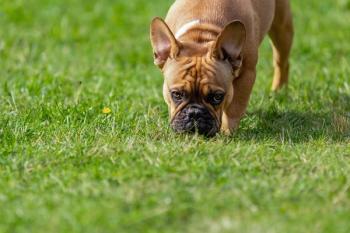
Diagnosing and managing canine eosinophilic bronchopneumopathy
Canine eosinophilic bronchopneumopathy (EBP) is an important differential diagnosis for cough and dyspnea that practitioners frequently overlook because it is relatively uncommon.
Canine eosinophilic bronchopneumopathy (EBP) is an important differential diagnosis for cough and dyspnea that practitioners frequently overlook because it is relatively uncommon. This condition, previously known as pulmonary infiltrates with eosinophils, has been defined as "a disease characterized by eosinophilic infiltration of lung and bronchial mucosa."1
Illustration by KO Studios
The inciting cause of the eosinophilic infiltration remains unknown in most cases. As such, EBP is considered an idiopathic disease.1 EBP differs from asthma in that spontaneous bronchial hyperreactivity and reversible airway obstruction (features that define asthma) are not typical components of this disorder.2 EBP has a great deal of relevance to practitioners as a condition that can be readily diagnosed and managed in a general practice setting with a favorable outcome in most cases. (See "
Figure 1A & Figure 1B. Left lateral thoracic and ventrodorsal radiographs of a dog with eosinophilic bronchopneumopathy showing a diffuse bronchial pattern with pulmonary nodules. (Photos courtesy of Diagnostic Imaging Section, Veterinary Teaching Hospital, Purdue University.)
CLINICAL PRESENTATION
EBP is most commonly seen in young adult dogs with an average age of 4 to 6 years.1,3 Females are affected more frequently than males.1,3 EBP has been described in Labrador retrievers, Alaskan malamutes, German shepherds, fox and Jack Russell terriers, dachshunds, Belgian shepherds, and Brittanies; Siberian huskies appear to be overrepresented.1,3-6 However, all breeds may be affected with this condition.
Figure 1B (Photo courtesy of Diagnostic Imaging Section, Veterinary Teaching Hospital, Purdue University.)
The most frequently observed clinical sign in dogs with EBP is cough, which is documented in 95% to 100% of cases.1,6 The cough is characterized as persistent and harsh and is typically followed by gagging or retching, likened to a "smoker's cough."1 Other common clinical signs include dyspnea, exercise intolerance, and nasal discharge that may be serous, mucoid, or mucopurulent.1,6 Lethargy and anorexia are usually not reported but may be noted if concomitant pneumonia is present.2 The clinical picture may vary from acute, life-threatening dyspnea to chronic, occasional cough.1,6,7
DIAGNOSTIC EVALUATION
Physical examination and laboratory evaluation
Performing a thorough physical examination is crucial for differentiating respiratory disease from gastrointestinal disease, which also may manifest as gagging and retching. Moreover, physical examination may reveal clues that suggest pulmonary diseases other than EBP (e.g. cachexia with neoplasia or fever with pneumonia). Physical examination findings may range from no abnormalities to pronounced dyspnea or tachypnea. Likewise, thoracic auscultation results may be entirely normal or reveal increased lung sounds, crackles, or wheezes.1 As stated above, nasal discharge may be present.
Figure 2A & Figure 2B. Bronchoscopy of a dog with eosinophilic bronchopneumopathy revealing yellow-green exudate within the bronchi. (Photos courtesy of Dr. Nolie Parnell, Clinical Associate Professor of Small Animal Internal Medicine, Department of Veterinary Clinical Sciences, Purdue University.)
Results of a serum chemistry profile and urinalysis are typically normal in dogs with EBP only. A peripheral eosinophilia is not necessary for diagnosis of EBP as a complete blood count will reveal a mild to marked eosinophilia in only 50% to 60% of cases.1,3,6,7 A leukocytosis, neutrophilia, basophilia, or combination of these is also frequently noted.1,3,6 To assess for a parasitic respiratory infection, a fecal examination using a Baermann technique and a zinc sulfate centrifugation-flotation test should be performed in all dogs presented for evaluation of a cough. Similarly, heartworm testing is mandatory for all dogs undergoing diagnostic investigation for respiratory disease.
Figure 2B (Photo courtesy of Dr. Nolie Parnell, Clinical Associate Professor of Small Animal Internal Medicine, Department of Veterinary Clinical Sciences, Purdue University.)
Imaging
Thoracic radiography is necessary to check for other conditions that may result in cough and dyspnea, including cardiac disease, chronic bronchitis, a foreign body, pulmonary or tracheobronchial neoplasia, fungal granulomas, and pneumonia. Yet, as with physical examination findings, radiographic findings associated with EBP are often variable and nonspecific.3 The most common radiographic abnormality is a diffuse, mixed bronchointerstitial pattern that is usually more severe than the pattern seen with chronic bronchitis.1 Other radiographic lesions that may be noted include alveolar infiltrates, peribronchial cuffing, bronchiectasis, pulmonary nodules, and bronchial wall thickening (Figures 1A & 1B).1,3,7 The severity of radiographic abnormalities appears to correlate with the severity of clinical signs.3,6
Cytology
Since radiographic findings are not specific enough to confirm EBP, airway cytology is essential for diagnosis. Cytologic samples from the airways may be collected by transtracheal aspiration, endotracheal washing, bronchoalveolar lavage, or bronchial brushing. Samples should be centrifuged immediately after collection or kept on ice until sample preparation is possible. After centrifugation, the pelleted cells should be transferred to a slide, air-dried, and then stained with a modified Wright's stain (Diff-Quik—Dade Behring) for microscopic evaluation.
Bronchoalveolar lavage may be performed with or without the guidance of a flexible bronchoscope. Bronchoscopy carries the advantage of allowing the bronchial mucosa to be directly observed, providing additional data to support the diagnosis. Abnormalities observed during bronchoscopy of patients with EBP include irregular to polyploid bronchial mucosa, mucosal hyperemia, copious yellow-green exudates, and, rarely, dynamic collapse of the bronchi during expiration (Figures 2A & 2B).1,3,6
During and following bronchoscopy or bronchoalveolar lavage, it is imperative to diligently monitor the patient's respiratory rate and character and blood oxygen saturation with pulse oximetry. Profound dyspnea and cyanosis, probably due to bronchoconstriction, were described following the procedure in one dog with eosinophilic airway disease.8
Figure 3. A bronchoalveolar lavage sample from a dog with eosinophilic bronchopneumopathy demonstrating eosinophilic and neutrophilic inflammation (modified Wright's stain). (Photo courtesy of Dr. Craig Thompson, Clinical Assistant Professor of Clinical Pathology, Department of Comparative Pathobiology, Purdue University.)
EBP is characterized by the predominance of eosinophils on cytologic examination of airway samples (Figure 3).1,3,6-8 In contrast, macrophages are the predominant cell type in samples from healthy dogs.9 Eosinophils compose 50% to 90% of the inflammatory cells in airway samples obtained from most dogs with EBP.1,6,8 Increased numbers of airway eosinophils may also be noted with other respiratory conditions such as neoplasia, parasitism, and fungal infection. Microscopic examination of airway samples may help detect these conditions if atypical cells, parasite larvae, or fungal organisms are observed. Concurrently, an increased percentage of neutrophils is often found in airway samples from dogs with EBP.1,3,6
Airway samples should always be submitted for quantitative bacterial cultures to detect concurrent bacterial infection. Impaired function of the mucociliary clearance apparatus secondary to inflammation can predispose patients to an accumulation of infectious organisms within the airways. It has been shown that bacterial growth of 1.7 x 103 CFU/ml of bronchoalveolar lavage fluid is necessary to distinguish true bacterial infection from colonization of the lower airways by commensal organisms.10 To further distinguish between commensal or contaminant organisms and true infection, culture results should be interpreted in the context of cytology results. Observation of etiologic agents within phagoyctic cells is supportive of true infection.
Biopsy
Airway cytology is sufficient to diagnose EBP in most cases, but bronchial pinch biopsies may be obtained with or without endoscopic guidance when cytologic examination results are equivocal. Typical histologic findings include eosinophilic infiltrates beneath or within the respiratory epithelium and varying degrees of mucosal thickening, infiltration by other inflammatory cell types, collagenolysis, and fibrosis.1,5
THERAPY
The primary goal of therapy for EBP is to decrease the severity of clinical signs. Clients should be informed that complete resolution of clinical disease rarely occurs even with appropriate treatment.1 The cornerstone of therapy is the reduction of lung and airway inflammation. However, anti-inflammatory corticosteroid therapy should be withheld until concurrent bacterial infection, if present, is eliminated.
Antimicrobial drugs should be selected based on bacterial culture and antimicrobial sensitivity results, and antimicrobials should be administered for two to four weeks or, ideally, until repeated bacterial cultures of the lower airways result in no growth. It is important to tell clients that clinical signs may not improve during the course of antimicrobial therapy. Mucolytic or expectorant agents are usually unnecessary, and cough suppressants should be avoided in order to allow for expectoration of mucus from the airways.
Since intermittent shedding of parasite ova may result in negative fecal examination results, a course of empirical anthelmintic therapy with fenbendazole (50 mg/kg orally once daily for 14 days) should also be prescribed.2 Give clients an anti-inflammatory dose of prednisone to administer in case their dogs have an acute progression of clinical signs, which may result from a profound inflammatory response to rapid parasite death.
Table 1
After the treatments for infectious agents are completed, prednisone or prednisolone (1 mg/kg orally every 12 hours for 21 to 28 days) is recommended for initial anti-inflammatory therapy.1,6 Instruct clients that poluria, polydipsia, and polyphagia are expected side effects of corticosteroid therapy. The therapeutic regimen is tailored by reducing the corticosteroid dose by 25% to 50% two weeks after clinical improvement is first noted and every two to three weeks thereafter if clinical improvement persists.1,6 Inhaled corticosteroids are associated with a reduced incidence of adverse systemic effects and have been shown to be effective in managing EBP.11,12 Inhalant corticosteroids such as fluticasone propionate may be substituted for oral corticosteroids or used in combination with a reduced dose of oral corticosteroids (Table 1). Inhaled corticosteroids are administered via a metered dose inhaler attached to a spacer device connected to a facemask (Figure 4). Corticosteroids can be discontinued in a minority of dogs, but most patients require lifelong therapy to control clinical signs.
Figure 4. An inhalant corticosteroid is administered to a dog with eosinophilic bronchopneumopathy by using a spacer and a facemask. (Photo courtesy of Dr. Corinne Goldman, South Carolina Veterinary Specialists.)
Because EBP is suspected to have an allergic etiology, potential allergenic triggers should be eliminated if possible. Aerosolized deodorizers and perfumes, particulate matter in bedding (cedar chips, straw, and sawdust), cigarette smoke, and dusty environments should be avoided.
PROGNOSIS
Most patients with EBP respond well to appropriate therapy, with clinical signs improving within days of initiating treatment.1,3,6,7 Irregular therapy with repository parenteral corticosteroids and abrupt cessation of oral corticosteroid therapy are associated with the poorest clinical responses.13 After the start of treatment, peripheral eosinophilia resolves and radiographic improvement is seen in most patients.1,6 Relapse may be noted weeks to months after discontinuation of therapy in some cases.1,3 If relapse occurs, reinstitute therapy with the lowest corticosteroid dose that controlled clinical signs, and follow a slower dose-tapering regimen.
CONCLUSION
Canine eosinophilic bronchopneumopathy is proposed to result from a hypersensitivity condition that leads to eosinophilic infiltration of the lower airways and pulmonary parenchyma, manifesting clinically as a harsh, unrelenting cough. It can be differentiated from chronic bronchitis by its occurrence in young dogs most commonly, the predominance of eosinophils in airway samples, and the occasional finding of concomitant nasal discharge. Therapy consists of anti-inflammatory oral or inhaled corticosteroids or a combination of these drugs. Complete resolution of clinical signs is rare, and most patients require lifelong treatment.
ACKNOWLEDGMENT
The authors thank Dr. Stephan Carey for his assistance in reviewing this manuscript.
Christine M. Venema, DVM
Coretta C. Patterson, DVM, DACVIM
Department of Small Animal Clinical Sciences
College of Veterinary Medicine
Michigan State University
East Lansing, MI 48824
REFERENCES
1. Clercx C, Peeters D, Snaps F, et al. Eosinophilic bronchopneumopathy in dogs. J Vet Intern Med 2000;14(3):282-291.
2. Clercx C, Peeters D. Canine eosinophilic bronchopneumopathy. Vet Clin North Am Small Anim Pract 2007;37(5):917-935.
3. Corcoran BM, Thoday KL, Henfrey JW, et al. Pulmonary infiltration with eosinophils in 14 dogs. J Small Anim Pract 1991;32(10):494-502.
4. Peeters D, Day MJ, Clercx C. Distribution of leucocyte subsets in bronchial mucosa from dogs with eosinophilic bronchopneumopathy. J Comp Pathol 2005;133(2-3):128-135.
5. Clercx C, Peeters D, German AJ, et al. An immunologic investigation of canine eosinophilic bronchopneumopathy. J Vet Intern Med 2002;16(3):229-237.
6. Rajamäki MM, Järvinen AK, Sorsa T, et al. Clinical findings, bronchoalveolar lavage fluid cytology and matrix metalloproteinase-2 and -9 in canine pulmonary eosinophilia. Vet J 2002;163(2):168-181.
7. Moon M. Pulmonary infiltrates with eosinophilia. J Small Anim Pract 1992;33(1):19-23.
8. Cooper ES, Schober KE, Drost WT. Severe bronchoconstriction after bronchoalveolar lavage in a dog with eosinophilic airway disease. J Am Vet Med Assoc 2005;227(8):1257-1262.
9. Hawkins EC. Bronchoalveolar lavage. In: King LG, ed. Textbook of respiratory disease in dogs and cats. Philadelphia, Pa.: WB Saunders, 2004;118-128.
10. Peeters DE, McKiernan BC, Weisiger RM, et al. Quantitative bacterial cultures and cytological examination of bronchoalveolar lavage specimens in dogs. J Vet Intern Med 2000;14:534-541.
11. Cohn LA, DeClue AE, Reinero CR. Endocrine and immunologic effects of inhaled fluticasone propionate in healthy dogs. J Vet Intern Med 2008;22(1):37-43.
12. Bexfield NH, Foale RD, Davison LJ, et al. Management of 13 cases of canine respiratory disease using inhaled corticosteroids. J Small Anim Pract 2006;47(7):377-382.
13. Bauer T. Pulmonary hypersensitivity disorders. In: Kirk RW, ed. Current veterinary therapy X. Philadelphia, Pa.: WB Saunders, 1989;369-376.
Newsletter
From exam room tips to practice management insights, get trusted veterinary news delivered straight to your inbox—subscribe to dvm360.




